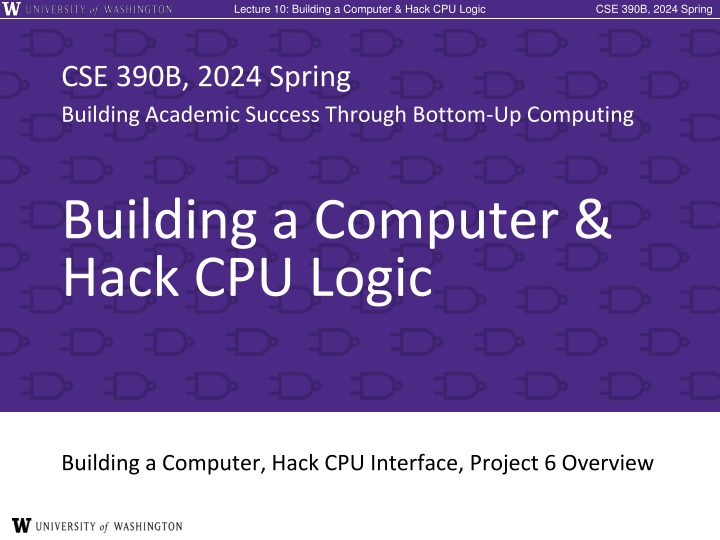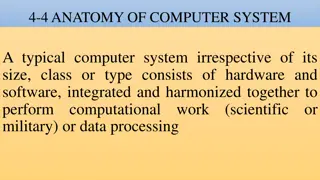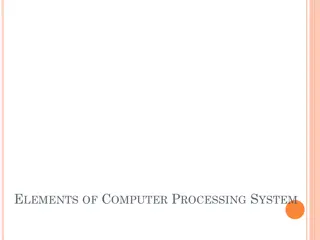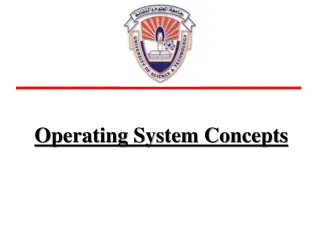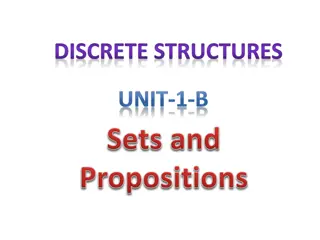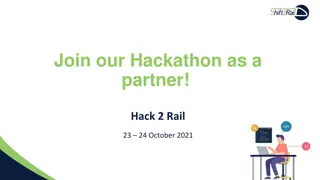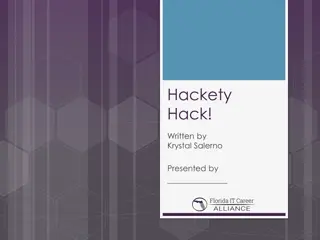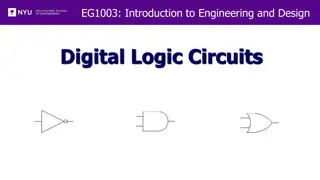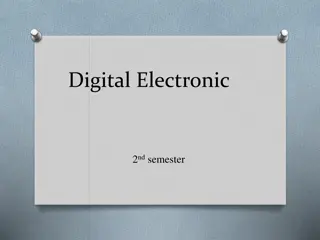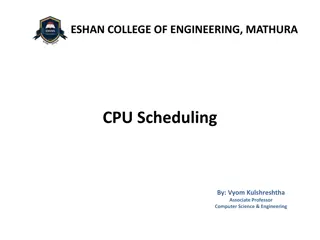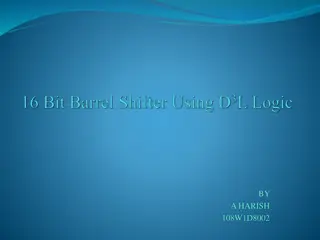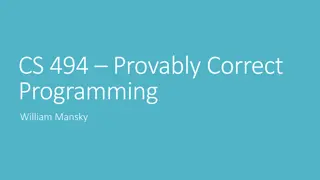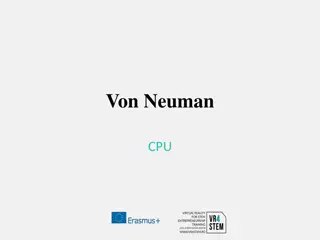Building a Computer & Hack CPU Logic Lecture
In this lecture on Building a Computer & Hack CPU Logic, students delve into the fundamentals of computer architecture, Von Neumann Architecture, connecting computers via buses, and the basic CPU loop. The session also covers fetching instructions and executing them in a continuous loop. The lecture outlines the importance of hardware efforts and the final project involving building Computer hdl.
Download Presentation

Please find below an Image/Link to download the presentation.
The content on the website is provided AS IS for your information and personal use only. It may not be sold, licensed, or shared on other websites without obtaining consent from the author.If you encounter any issues during the download, it is possible that the publisher has removed the file from their server.
You are allowed to download the files provided on this website for personal or commercial use, subject to the condition that they are used lawfully. All files are the property of their respective owners.
The content on the website is provided AS IS for your information and personal use only. It may not be sold, licensed, or shared on other websites without obtaining consent from the author.
E N D
Presentation Transcript
Lecture 10: Building a Computer & Hack CPU Logic Lecture 10: Building a Computer & Hack CPU Logic CSE 390B, 2024 Spring CSE 390B, 2024 Spring CSE 390B, 2024 Spring Building Academic Success Through Bottom-Up Computing Building a Computer & Hack CPU Logic Building a Computer, Hack CPU Interface, Project 6 Overview
Lecture 10: Building a Computer & Hack CPU Logic CSE 390B, 2024 Spring Lecture Outline Building a Computer Architecture, Fetch and Execute Cycle Hack CPU Interface Implementation and Operations Project 6 Overview Mock Exam Problem and Project Tips 2
Lecture 10: Building a Computer & Hack CPU Logic CSE 390B, 2024 Spring Building a Computer All your hardware efforts are about to pay off! Perspective: BUILDING A COMPUTER In Project 6, you will build Computer.hdl, the final, top-level chip in this course For all intents and purposes, a real computer Simplified, but organization very similar to your laptop Project 7 onward, we will write software to make it useful 3
Lecture 10: Building a Computer & Hack CPU Logic CSE 390B, 2024 Spring Von Neumann Architecture COMPUTER MEMORY CPU 0 1 2 0101110011100110 1011000101010100 1110001011111100 ... INPUT OUTPUT Instructions n n+1 n+2 1100101010010101 1100100101100111 0011001010101011 ... REGISTERS CONTROL Data 4
Lecture 10: Building a Computer & Hack CPU Logic CSE 390B, 2024 Spring Connecting the Computer: Buses COMPUTER MEMORY CPU 0 1 2 0101110011100110 1011000101010100 1110001011111100 ... INPUT OUTPUT Instructions n n+1 n+2 1100101010010101 1100100101100111 0011001010101011 ... REGISTERS CONTROL Data Control Bus Address Bus Data Bus 5
Lecture 10: Building a Computer & Hack CPU Logic CSE 390B, 2024 Spring Basic CPU Loop Repeat forever: Fetch an instruction from the program memory Execute that instruction 6
Lecture 10: Building a Computer & Hack CPU Logic CSE 390B, 2024 Spring Fetching Specify which instruction to read as the address input to our memory Data output: actual bits of the instruction Memory Output: Data MEMORY Instruction D=A;JMP 0 1 2 0101110011100110 1011000101010100 1110001011111100 ... Instructions n n+1 n+2 1100101010010101 1100100101100111 0011001010101011 ... Memory Input: Address Data PC 1 Instruction Address 7
Lecture 10: Building a Computer & Hack CPU Logic CSE 390B, 2024 Spring Executing The instruction bits describe exactly what to do A-instruction or C-instruction? Which operation for the ALU? What memory address to read? To write? If I should jump after this instruction, and where? Executing the instruction involves data of some kind Accessing registers Accessing memory 8
Lecture 10: Building a Computer & Hack CPU Logic CSE 390B, 2024 Spring Combining Fetch & Execute Memory Output: Data MEMORY Instruction D=A;JMP 0 1 2 0101110011100110 1011000101010100 1110001011111100 ... Data 245 Instructions Memory Input: Address n n+1 n+2 1100101010010101 1100100101100111 0011001010101011 ... PC 1 Instruction Address Data Data Address (From instruction or register) 9
Lecture 10: Building a Computer & Hack CPU Logic CSE 390B, 2024 Spring Combining Fetch & Execute Memory Output: Data MEMORY Instruction D=A;JMP 0 1 2 0101110011100110 1011000101010100 1110001011111100 ... Data 245 Instructions Memory Input: Address n n+1 n+2 1100101010010101 1100100101100111 0011001010101011 ... PC 1 Instruction Address Data Data Address (From instruction or register) Could we implement with RAM16K.hdl? (Hint: Think about the I/O of RAM) 10
Lecture 10: Building a Computer & Hack CPU Logic CSE 390B, 2024 Spring Combining Fetch & Execute Memory Output: Data MEMORY Instruction D=A;JMP 0 1 2 0101110011100110 1011000101010100 1110001011111100 ... Data 245 Instructions Memory Input: Address n n+1 n+2 1100101010010101 1100100101100111 0011001010101011 ... PC 1 Instruction Address Data Data Address (From instruction or register) Could we implement with RAM16K.hdl? No! Our memory chips only have one input and one output 11
Lecture 10: Building a Computer & Hack CPU Logic CSE 390B, 2024 Spring Solution 1: Handling Single Input / Output Memory Output: Data Instruction, when fetching MEMORY DMux 0 1 2 0101110011100110 1011000101010100 1110001011111100 ... Data, when executing Instructions Memory Input: Address n n+1 n+2 1100101010010101 1100100101100111 0011001010101011 ... Instruction Address Mux Data Address Data Fetching vs. Executing Can use multiplexing to share a single input or output 12
Lecture 10: Building a Computer & Hack CPU Logic CSE 390B, 2024 Spring Solution 1: Fetching / Executing Separately Fetching vs. Executing Memory Output: Data Instruction, when fetching MEMORY Register DMux 0 1 2 0101110011100110 1011000101010100 1110001011111100 ... Data, when executing Instructions Memory Input: Address n n+1 n+2 1100101010010101 1100100101100111 0011001010101011 ... Instruction Address Mux Data Address Data Fetching vs. Executing Need to store fetched instruction so it s available during execution phase 13
Lecture 10: Building a Computer & Hack CPU Logic CSE 390B, 2024 Spring Solution 2: Separate Memory Units Separate instruction memory and data memory into two different chips Each can be independently addressed, read from, written to Pros: Simpler to implement Cons: Fixed size of each partition, rather than flexible storage Two chips redundant circuitry 14
Lecture 10: Building a Computer & Hack CPU Logic CSE 390B, 2024 Spring Lecture Outline Building a Computer Architecture, Fetch and Execute Cycle Hack CPU Interface Implementation and Operations Project 6 Overview Mock Exam Problem and Project Tips 15
Lecture 10: Building a Computer & Hack CPU Logic CSE 390B, 2024 Spring Hack CPU COMPUTER RAM (Data) ROM CPU (Instructions) data out instr 0 1 2 100110010111 100011001111 000000000010 ... 0 1 2 010111001110 101100010101 111000101111 ... Data Instructions REGISTERS data in addr of next instruction CONTROL INPUT OUTPUT 16
Lecture 10: Building a Computer & Hack CPU Logic CSE 390B, 2024 Spring Hack CPU Interface Inputs inM: Value coming from memory instruction: 16-bit instruction reset: if 1, reset the program 17
Lecture 10: Building a Computer & Hack CPU Logic CSE 390B, 2024 Spring Hack CPU Interface Outputs outM: value used to update memory if writeM is 1 writeM: if 1, update value in memory at addressM with outM addressM: address to read from or write to in memory pc: address of next instruction to be fetched from memory 18
Lecture 10: Building a Computer & Hack CPU Logic CSE 390B, 2024 Spring Hack CPU Implementation pc 19
Lecture 10: Building a Computer & Hack CPU Logic CSE 390B, 2024 Spring Hack CPU Implementation (each "C" symbol represents a control bit) 20
Lecture 10: Building a Computer & Hack CPU Logic CSE 390B, 2024 Spring CPU Operation: Instruction Handling (each "C" symbol represents a control bit) 21
Lecture 10: Building a Computer & Hack CPU Logic CSE 390B, 2024 Spring CPU Operation: Instruction Handling @5 0000000000000101 A-instruction 22
Lecture 10: Building a Computer & Hack CPU Logic CSE 390B, 2024 Spring CPU Operation: Instruction Handling @5 0000000000000101 A-instruction CPU handling of an A-instruction: Decodes the instruction into: op-code 15-bit value Stores the value in the A-register Outputs the value (not shown in this diagram) 23
Lecture 10: Building a Computer & Hack CPU Logic CSE 390B, 2024 Spring CPU Operation: Instruction Handling C-instruction D=D+1;JMP 1110011111010111 24
Lecture 10: Building a Computer & Hack CPU Logic CSE 390B, 2024 Spring Hack: C-Instructions Symbolic: dest = comp ; jump Binary: 1 1 1 a c1 c2 c3 c4 c5 c6 d1 d2 d3 j1 j2 j3 Comp: ALU Operation (a bit chooses between A and M) Dest: Where to store result Jump: Condition for jumping Family: C-Instruction Unused 25
Lecture 10: Building a Computer & Hack CPU Logic CSE 390B, 2024 Spring CPU Operation: Instruction Handling C-instruction D=D+1;JMP 1110011111010111 CPU handling of a C-instruction: Decodes the instruction bits into: Op-code ALU control bits Destination load bits Jump bits Routes these bits to their chip-part destinations The chip-parts (most notably, the ALU) execute the instruction 26
Lecture 10: Building a Computer & Hack CPU Logic CSE 390B, 2024 Spring Hack: C-Instructions Symbolic: dest = comp ; jump Binary: 1 1 1 a c1 c2 c3 c4 c5 c6 d1 d2 d3 j1 j2 j3 Comp: ALU Operation (a bit chooses between A and M) Important: just pattern matching text! Cannot have 1+M Chapter 4 27
Lecture 10: Building a Computer & Hack CPU Logic CSE 390B, 2024 Spring CPU Operation: Handling C-Instructions 011111 1 01 1110011111010111 1 10 writeM ALU data inputs: ALU control inputs: Input 1: from the D-register Control bits (from the instruction) Input 2: from either: A-register, or data memory 28
Lecture 10: Building a Computer & Hack CPU Logic CSE 390B, 2024 Spring Hack: C-Instructions Symbolic: dest = comp ; jump Binary: 1 1 1 a c1 c2 c3 c4 c5 c6 d1 d2 d3 j1 j2 j3 Dest: Where to store result Chapter 4 29
Lecture 10: Building a Computer & Hack CPU Logic CSE 390B, 2024 Spring CPU Operation: Handling C-Instructions 1 011111 0 1 01 0 11 1110011111010111 1 10 writeM 0 ALU data output: Result of ALU calculation Fed simultaneously to: D-register, A-register, data memory Which destination actually commits to the ALU output is determined by the instruction s destination bits 30
Lecture 10: Building a Computer & Hack CPU Logic CSE 390B, 2024 Spring CPU Operation: Handling C-Instructions 011111 1 01 0 11 1110011111010111 1 10 writeM ALU control outputs: Is the output negative? Is the output zero? 31
Lecture 10: Building a Computer & Hack CPU Logic CSE 390B, 2024 Spring CPU Operation: Control pc 32
Lecture 10: Building a Computer & Hack CPU Logic CSE 390B, 2024 Spring CPU Operation: Control 33
Lecture 10: Building a Computer & Hack CPU Logic CSE 390B, 2024 Spring CPU Operation: Control 16 load 1 pc 16 PC operation (abstraction) Address of next instruction Outputs the address of the next instruction: Restart: PC = 0 No jump: PC++ Go to: PC = A Conditional go to: if (condition) PC = A else PC ++ 34
Lecture 10: Building a Computer & Hack CPU Logic CSE 390B, 2024 Spring Hack: C-Instructions Symbolic: dest = comp ; jump Binary: 1 1 1 a c1 c2 c3 c4 c5 c6 d1 d2 d3 j1 j2 j3 Jump: Condition for jumping Chapter 4 35
Lecture 10: Building a Computer & Hack CPU Logic CSE 390B, 2024 Spring CPU Operation: Control 111 a c c c c c c d d d j j j 16 load 1 pc 16 PC operation (implementation) if (reset==1) PC = 0 Address of next instruction else // In the course of handling the current instruction: load = f (jump bits, ALU control outputs) if (load == 1)PC = A // jump else PC++ // next instruction 36
Lecture 10: Building a Computer & Hack CPU Logic CSE 390B, 2024 Spring Hack CPU Implementation: That s It! 37
Lecture 10: Building a Computer & Hack CPU Logic CSE 390B, 2024 Spring Lecture Outline Building a Computer Architecture, Fetch and Execute Cycle Hack CPU Interface Implementation and Operations Project 6 Overview Mock Exam Problem and Project Tips 38
Lecture 10: Building a Computer & Hack CPU Logic CSE 390B, 2024 Spring Project 6: Overview Part I: Mock Exam Problem Part II: Building a Computer LoadAReg.hdl, LoadDReg.hdl (Easier) JumpLogic.hdl (Medium) CPU.hdl (Harder) Computer.hdl (Easier) Part III: Project 6 Reflection 39
Lecture 10: Building a Computer & Hack CPU Logic CSE 390B, 2024 Spring Project 6, Part I: Mock Exam Problem Your group will meet for a 30-minute session to do one mock exam problem Your group s mock exam problem will be emailed right before your session Your 30-minute session will include: Set up: 5 minutes Mock Exam Problem: 10 minutes Debrief & Reflection: 15 minutes Part I task: Submit the completed mock exam problem and complete the reflection questions 40
Lecture 10: Building a Computer & Hack CPU Logic CSE 390B, 2024 Spring Project 6, Part II Tips CPU.hdl: We provide an overview diagram, but there are details to fill in, especially control Draw your own detailed diagram first Handling jumps will require a lot of logic sketch out the cases Textbook chapter 4 and 5 helpful for Project 6 Multi-Bit Buses: MSB to the left, LSB to the right Important to keep in mind when taking apart the instruction Debugging: Consult .out and .cmp files to debug, then look at internal wires in simulator See also the Debugging tips section of the specification 41
Lecture 10: Building a Computer & Hack CPU Logic CSE 390B, 2024 Spring Lecture 10 Reminders Project 5: Annotation, Machine Language, Computer Memory due tonight (4/26) at 11:59pm CSE 390B midterm next Friday (5/3) during lecture Project 6 (Mock Exam Problem & Building a Computer) released today, due in two Fridays (5/10) at 11:59pm Eric has office hours after class in CSE2 153 Feel free to post your questions on the Ed board as well 42
